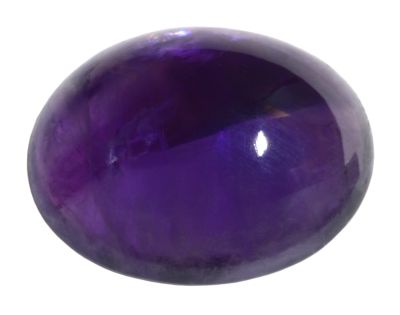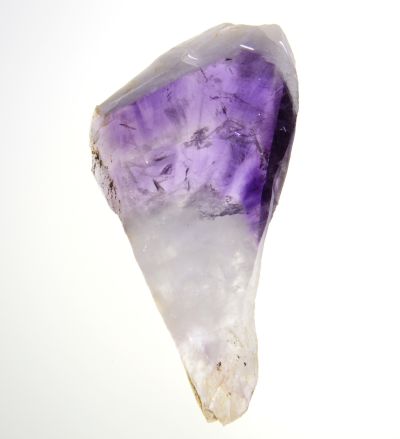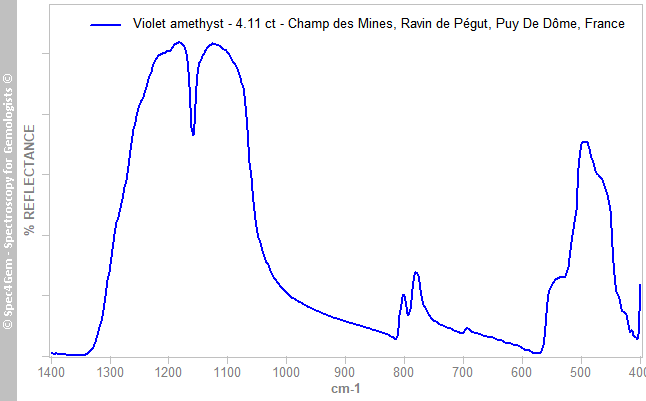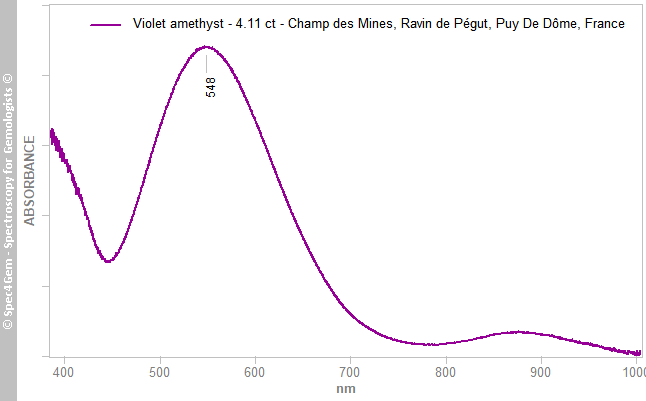French amethyst from Auvergne
- Details
- Created: Saturday, 25 November 2017 21:28
Amethyst is the purple color variety of crystalline quartz and is the most popular gemstone from ages past. Even if the definition gives purple as the color (with various saturation, from very light to very dark), it is often violet rather than purple. Commercial production is mainly from South America and Africa but it is also available in many other places on earth.
The stone (figure 1) being studied here comes from Le champ des Mines in Pégut ravine near the village La Chapelle sur Usson in Puy de Dôme, Auvergne, France where it is traditionally (manually) mined without any excavator. Amethyst has been mined there from time to time for centuries, especially since the 16th century.
 Figure 1. The 4.11 ct violet amethyst cab from the Champ des Mines,
Figure 1. The 4.11 ct violet amethyst cab from the Champ des Mines,Ravin de Pégut, Puy de Dôme, Auvergne, France
| Shape | oval cab |
| Size | 12.3 x 9.5 x 5.0 mm |
| Color | violet with color zoning (different shade of purple / violet) |
| Lustre | vitreous |
| Weight | 4.11 ct |
| SG | 2.65 |
| RI | 1.544 - 1.553 |
| DR | 0.009 U+ |
| Pleochroism | weak: very slightly bluish violet / very slightly reddish violet |
| Polariscope / Conoscope | anisotropic: light/dark 4 times / 360°, C-axis seems to be parallel to the stone's length but uniaxial figure cannot be observed with conoscope |
| SWUV | inert |
| LWUV | inert |
| Magnetic susceptibility N52 | diamagnetic |
| Chelsea filter | reddish violet if viewed under an incandescent light |
Table 1. Observational and measured properties
 Figure 2. A slice of a quartz crystal from the Pégut locality shows its
Figure 2. A slice of a quartz crystal from the Pégut locality shows itsgrowing structure revealing the milky-white hooded amethyst.
The figure 2 shows a crystal from the locality, sliced and polished of about 21.5 x 10.9 x 3.0 mm. The optical and physical properties (RI, SG, ...) are identical to that of the cab (table 1) as well as the IR (figure 3) and UV-Vis-NIR (figure 4) spectra (as far the violet colored zone is concerned). The picture clearly shows the growing structure of the crystal with the variation of the fluid source (hydrothermal process) over the time. The crystal has incorporated iron in its lattice structure after a half of its growing height, and then iron disappeared from the fluid source up to the end of the crystallization phase. Gamma radiation have completed the job by oxidizing the Fe3+ to Fe4+ over the time giving the violet color to this quartz crystal. The final growing phase that remained white makes a distinctive feature characteristic of the locality known as milky-white hooded amethyst. Another great feature but not least, is the pseudo-cubic habitus of some crystals which is encountered in few worldwide localities as listed by Mindat[1]: Austria, France, Germany, Italy, Madagascar and USA.
For more details, refer to the following publications of F. Périnet:
Infrared reflectance spectroscopy:
The IR reflectance spectrum (figure 3) was acquired from the cab's top and shows the spectrum pattern of characteristic crystalline quartz observed on crystal faces parallel to C-axis.
 Figure 3. IR reflectance spectrum of the 4.11 ct violet amethyst showing a characteristic spectrum pattern of crystalline quartz observed on crystal faces parallel to C-Axis.
Figure 3. IR reflectance spectrum of the 4.11 ct violet amethyst showing a characteristic spectrum pattern of crystalline quartz observed on crystal faces parallel to C-Axis. UV-VIS-NIR spectroscopy:
The UV-Vis-NIR spectrum (figure 4) was acquired with the light path crossing from the top to the bottom (back) of the cab, in other words in a direction almost perpendicular to the C-axis of the original crystal. Polarizing filter was used to split Extraordinary and Ordinary -rays but since both spectra gave the same pattern except for a weak difference over the 800-1000 nm range, it was decided to display only an unoriented spectrum. The spectrum shows a main absorption band centered at 548 nm caused by Fe4+ resulting of oxidization of Fe3+ ions by natural gamma radiation.
 Figure 4. Unoriented UV-Vis-NIR spectrum of the 4.11 ct violet amethyst showing a main absorption band centered at 548 nm. This absorption band is caused by Fe4+ resulting of oxidization of Fe3+ ions by natural gamma radiation.
Figure 4. Unoriented UV-Vis-NIR spectrum of the 4.11 ct violet amethyst showing a main absorption band centered at 548 nm. This absorption band is caused by Fe4+ resulting of oxidization of Fe3+ ions by natural gamma radiation.Photoluminescence spectroscopy:
No photoluminescence with the common sources: 254, 280, 377, 405 nm.
Conclusion:
No doubt this stone is an amethyst but it is rather rare to have the description of a french stone nowadays available for jewelry. It is important to support the hard work of this family business which is behind the scene to bring us these beauties (we do not also forget all miners in the world that work very hard to make gemstones available).

